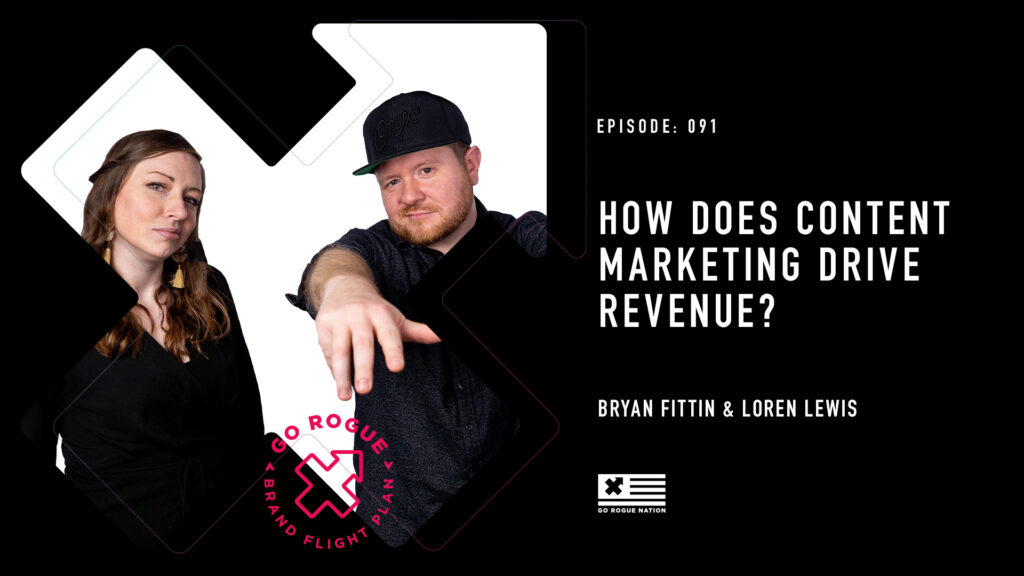Summary
In this episode of Rogue Creators, Bryan and Loren talk about using content marketing to drive revenue. Many executives and traditionally-minded people are skeptical about content marketing being effective and producing an ROI, but we believe differently. Bryan and Loren discuss how engagement affects revenue, reaching early-stage customers, and utilizing analytics to create the most compelling content. Thanks for tuning in!
Shownotes
(1:47) What are you obsessed with?
(8:41) How does engagement affect revenue?
(13:20) Reaching early-stage customers
(17:12) Utilizing analytics
(22:26) Wrap up
(24:42) Rapid fire
Links
Quotes
“When it drives the bottom line, I mean, that is one of those things of, you have an insight into what your audience is looking for. And so, double down on that. Reproduce that again and again and again. Whether it was the guest, or you know, the image or graphic, or however it was created.” (9:06)
“If you’re using your analytics to say, ‘Well, I got 57 likes on this comment,’ you’re not using your analytics well.” (18:13)
How Does Content Marketing Drive Revenue?
One of the most common questions that prospective clients and other business owners ask us is, “What is the ROI?” Everyone wants to know how to maximize revenue, and some people are skeptical that digital marketing, and more specifically content marketing, impact revenue. When used inefficiently or incorrectly, skeptics will find that they are correct, but content marketing is a powerful avenue for driving revenue when it is handled appropriately. Are you interested in how content marketing can increase revenue? Check out these tips and tricks:
Understanding Engagement
With content marketing, engagement is one of the critical factors in driving revenue. Your audience should primarily be potential clients, customers, and buyers, and engaging with them on social media platforms allows them to get to know you. They’ll put a face to your brand, and as they get to know you, they can start liking and trusting you.
When we talk about engagement, you must understand that we are not talking about getting likes on your content. While likes are fun, they are not the helpful source of feedback we are looking for. Instead, look at who is sharing and commenting on your content. This is the quality of engagement that you will want to track.
While engagement in the form of shares helps put you in front of a new, un-reached audience, comments should be seen as a relationship-building tool. It is the first step in knowing your audience and your audience knowing you.
What types of content promote engagement? Helpful tips and educational content is excellent, as people love to share what they’ve learned with their followers. Current, relevant content is ideal for encouraging comments. People love to talk about what’s going on in the world, and tastefully inserting your brand into that conversation can be quite effective.
Reaching Early-Stage Customers
Ultimately, the goal of content marketing is to reach new customers. After all, that’s how we drive revenue and show proof of ROI, right? But how do you use your engagement to generate new sales?
The first step in this process is to not sell to the people you are engaging with, or at least not at first. The potential customers we are referring to are at the very beginning of the sales process. You won’t have a lot of success selling to them immediately, as you need them to know, like, and trust you to see regular success.
Instead of selling to them right out of the gate, get to know them and prove your value. Post content that is knowledge and value-based. Prove to them that you know what you’re talking about, and when they engage with your content, respond to them! View this stage as an opportunity to build a relationship.
When you continually prove your value to this audience, they will want to work with you!
Utilizing Analytics
Tracking analytics might seem like the most challenging part of this process, but it doesn’t have to be. You’ve created and posted your content, you responded to the comments you received, and now you have a bunch of numbers from analytics reports about your engagement. What information is important, and what do you do with it?
The best place to start is understanding which numbers matter. As we’ve already addressed, likes are not part of the critical numbers. Instead, look at which content regularly receives a lot of engagement through comments and shares. When you know what kind of content is getting the most engagement, make more of it! Engagement analytics allow you to understand what your audience likes, and if you aren’t using this information to inform yourself, you are wasting your time!
Analytics are also helpful for understanding when and where you should be posting your content. Do the numbers show that posts before 5 pm don’t get as much engagement as posts after 5? Stop posting before 5! Is the content on Facebook getting less engagement than the same content you post on Instagram and LinkedIn? Focus on your Instagram and LinkedIn presence, and quit worrying about Facebook.
These insights will be different for every industry and brand, but the principles are the same. Understanding your engagement analytics will help you provide the right content at the right time.
Are you interested in talking more about content marketing, engagement, and analytics? Click Here!


